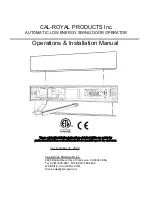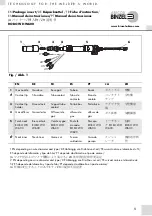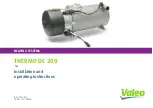
A951
56
532081 - RevA
Tr
ansla
tion of the original instruc
tions
ENGLISH
12.3 ROUTINE MAINTENANCE
Table
21
lists the operations which must be performed on a regular basis in order to keep the automation
working reliably and safely; these are given purely as a guideline and should not be considered exhaustive. The
installer/machine manufacturer is responsible for drawing up the maintenance plan for the automation,
supplementing this list or modifying the maintenance operations on the basis of the machine characteristics.
21
Scheduled maintenance
Operations
Frequency/months
Structures
Check the structures and the parts of the building to which the door and the automation is fixed: make sure there is no damage,
cracking, breaks or subsidence.
12
Frame
Check the frame: make sure that it is fixed correctly, that it is integral and that there is no deformation or damage. Tighten screws
and bolts where necessary.
12
Check the leaf: that it is integral and that there is no deformation or damage.
12
Check the hinges: make sure that they are fixed correctly, that they are integral, correctly positioned in their seats and that there is
no deformation or damage.
12
Lubricate hinges or locks, if necessary.
12
Perform a general clean of the area of movement of the door.
12
Check the presence and condition of pictograms that highlight the glass part of the door. If they are missing or damaged, replace
them.
12
Operator
Check that the cover/casing and all the movable guards are integral and that they are fastened correctly. Tighten screws and
bolts where necessary.
12
Check the condition of the power cables, the sensor and accessory connection cables and the relative cable glands.
12
Check the charge of the emergency battery, if present.
12
Replace the emergency battery, if present.
48
General cleaning.
12
Function set-up selector and keyboard
Check that they are intact and operating correctly.
12
Sensors, protective devices and control devices
Check that they are intact and operating correctly.
12
If applicable, check that the pictograms that identify the control devices for disabled persons are present and intact.
12
The door
Check that the door operates properly in both directions with all the devices installed.
12
Check that the door moves smoothly and uniformly without making any unusual noises.
12
Check that the opening and closing speed is correct. For doors in “low energy” mode, make sure that the opening and closing
times are within the limits permitted by the regulations.
6
For doors in “low energy” mode, make sure that it is possible to stop the movement of the door without excessive force (Max. 67N)
at any point along its travel.
6
Check that the door operates correctly in every operating mode.
12
Check that the lock is working properly, if present.
6
Check that the safety system is working correctly (door reverses or stops when an obstacle is detected, that the door stops in the
open position when there is an obstacle in the area of movement etc.)
6
Check that the door's CE marking and the DANGER, AUTOMATIC MOVEMENT warning sign is present, intact and legible.
12
Summary of Contents for A951
Page 1: ...A951 EN16005...
Page 65: ......











































